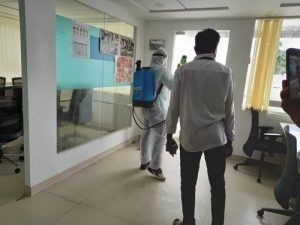Pest Control Henderson NV may involve several strategies. The best one for your situation will depend on the pest, its environment, and its limitations.
Always try to use the least toxic method possible. If a pest is not causing harm, our ability to tolerate it may be higher. Seal cracks and crevices, caulk windows, put screens on outside doors and repair torn window screens.

Pest identification is the first step in any pest control program. It allows you to determine what type of insect, weed, vertebrate animal or microbe is present and whether it causes damage. This information can be used to develop integrated pest management (IPM) strategies that reduce or eliminate the pest problem without the use of toxic chemicals. Pest identification also helps prevent accidental contamination of food crops, natural areas and collections of artifacts by inappropriate control methods.
Proper pest identification depends on a knowledge of the pest’s life cycle and habits as well as environmental factors that favor its development and reproduction. Accurate identification can also help you decide whether the pest is a threat to your crops, plants or collection items and how urgently it needs to be controlled.
Often, pests can be confused with similar organisms as they go through their life stages. An immature beetle may look like a caterpillar or worm, for example. If you do not know what type of pest you are dealing with, you can try to identify it by its shape or other physical characteristics, examining damage caused by the pest and observing the habitat where it is found.
You should regularly sample the crop in order to monitor pest numbers. Sampling can occur weekly, daily or at irregular intervals, depending on the need to monitor and the level of damage being caused by the pest. Sampling early in the season is usually recommended because it will allow you to detect pests sooner, before populations increase to damaging levels.
Monitoring results can be compared to historical records in order to predict when pests will become a serious problem. This information can be used to determine the best timing for IPM practices or to plan for a rapid response to the pest problem when it occurs.
Once the identity of a pest is determined, you can learn about its life cycle and habitat requirements, its food sources and when and where it reproduces. This information can help you decide how and when to implement an IPM plan to prevent or eliminate the pest problem.
Pest Control Methods
Pest control methods aim to limit the damage caused by pests. These methods may involve changing the environment in which pests live to make it less suitable for them, or they may use biological, physical, or chemical controls.
Before taking any action, the pest must be correctly identified to ensure that the correct control method is used. A plan must then be devised to achieve desired outcomes, which can be divided into prevention – stopping a pest from becoming a problem, suppression – reducing the population below damaging levels, and eradication – eliminating a pest entirely.
Preventive measures include removing food sources, keeping garbage cans sealed, and keeping the yard and surrounding buildings clean. Physical controls include window screens to keep health pests out of buildings, floating row covers for many horticultural crops, and cardboard bands that catch codling moth larvae in apple trees. Chemical pesticides are also used, although it is important to apply them only where necessary and to do so at the right time.
Biological control involves using natural enemies to reduce pest populations. For example, bacteria and other microorganisms can infect insect pests to cause disease epidemics that reduce their numbers. Other biological controls include the use of pheromones, which are chemicals emitted by host plants that affect insect pest behavior, and juvenile hormones, which prevent insects from developing into adulthood.
Cultural and physical controls change the environment in which pests live to make the conditions unsuitable for them. For example, weeds can be removed from fields before planting to prevent them from providing habitat for pests. Cover cropping can be used to attract beneficial organisms that will protect other crops from pests. Planting in rows and thinning to avoid overcrowding can help with crop protection. Other cultural practices, such as avoiding the use of contaminated soil, can also help to prevent pests. These methods are less expensive than using pesticides and can deliver results more quickly, although they do not always provide immediate solutions. However, they may require more frequent applications and often do not work against pests that have already become established.
Pesticides
A pesticide is any substance intended for use for preventing, destroying, repelling or controlling unwanted species of plants or animals. The term pesticides refers to a wide variety of chemicals including insecticides, herbicides, fungicides and nematicides.
Pesticides are generally highly effective and can be rapidly implemented over large areas to control pest populations. Generally, however, they should be used only as part of an integrated pest management (IPM) program that includes other nonchemical methods. Overuse or misuse of pesticides can result in environmental degradation and human health risks.
All pesticides are toxic to some extent to both the targeted plant and the environment. When selecting and using a pesticide, choose the least-toxic option that is effective against the pests you are trying to control. Consider the impacts of pesticides on wildlife, other gardeners, pets, family members and local water quality and contaminate the environment as little as possible.
Selecting a pesticide with the right formulation, timing and application method will also reduce environmental impacts. For example, the use of wettable powder formulations may result in less runoff and leaching than emulsified concentrates or liquid suspensions.
Avoid spraying when the wind is blowing or rain is imminent, as this can wash the pesticide into nearby plants and water bodies. Also, spraying for a pest that is not present can waste pesticide, cause plant injury and contaminate the environment with excess chemicals.
Always follow the directions on the pesticide label and wear the protective clothing suggested. Remember that a small amount of any pesticide can be harmful or even fatal to people and pets. Always store pesticides out of reach of children, in a secure place like a locked cabinet or cupboard in the garage or basement. Remove bird cages and fish tanks and move other pets to another area before applying an aerosol pesticide.
Pesticide residues are typically present in food crops after they are sprayed. Many states have Minimum Residue Levels (MRL) that must be met before a crop can be sold for human consumption. In a 1998 survey of four commodities (oranges, peaches, carrots and spinach), residues were found in 32% of the samples. These residues were caused by organochlorine, carbamate and pyrethroid pesticides. The use of these chemicals is being phased out or restricted due to their toxic effects on humans and other organisms.
Prevention
As the name suggests, pest control is the process of preventing and controlling infestations or damage to plants, animals, and property. There are several methods to achieve this, including a number of organic approaches that minimize or eliminate the need for chemical products. Other approaches include biological control through the use of predators, parasites, and pathogens; cultural controls that involve a modification in cultivation techniques; and physical and hygienic methods to prevent the spread of pests. Integrated Pest Management (IPM) utilizes all of these methods to minimize the need for pesticides, and when necessary, employs chemical treatments sparingly with targeted applications.
When it comes to preventive measures, the first step is learning more about your pest: what it looks like, where it goes during the day and night, and how it reproduces. This information will help you determine whether it presents a threat to your health or the environment and may inspire ideas about how to stop or slow its advance.
Scouting and monitoring are important components of prevention: identify the pest, find out what it feeds on or where it nests, and learn what conditions encourage its growth and development. For instance, a mosquito problem is often exacerbated by stagnant water and warm temperatures; preventing mosquito breeding and feeding will reduce the mosquito population and the associated risk of disease.
In addition to reducing food, water and shelter sources, prevention also includes reducing clutter: remove stacks of paper, magazines, and cardboard where pests can breed and hide. Seal cracks and crevices, especially around cabinets and baseboards, and repair leaky plumbing. Caulk or plaster can be used to create a permanent seal, but steel wool and wire mesh are better for repairing holes.
Finally, consider your tolerance level for the pest in question. For example, a few wasps visiting your garden periodically probably aren’t cause for concern, but if they seem to be everywhere you look and their numbers continue to rise, then it’s time for action. Using the threshold-based decision-making method, decide on what you’re willing to tolerate and when you will take steps to stop or limit pests.



